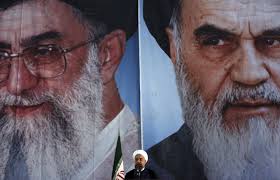
On February 11, 1979, Ayatollah Ruhollah Khomenei came to power in Iran, installing a theocratic regime in place of the Shah’s US-backed authoritarian monarchy. Forty years on, has this Revolution achieved what it set out to do?
FRANCE 24 examined these questions with Azedeh Kian, an Iran specialist and a professor of political sociology at Paris Diderot University.
What did Ayatollah Khomenei vow to achieve at the time of the Revolution, and have his promises been kept?
Well, Khomeini’s promises have been broken. For starters, he said that Iran’s wealth would be redistributed for the benefit of the whole population – but the country’s wealth is monopolised by a tiny minority of people, who are either in power themselves or subordinate to the regime. And that’s not to mention corruption, which the religious authorities who came to power in 1979 swore to stamp out. It’s still very much in place.
In the late 1970s there was great pressure from Iranian civil society – not to overthrow the Shah – but for reform and social justice. Students, intellectuals, the urban, educated classes were calling on the monarch to allow freedom of expression. But it seems the Shah lacked the intelligence to hear this message, and soon the demand for change was hijacked by Islamists. So now there is no freedom or social justice in Iran.
The gap between the rich and the poor in the country – which was already a problem in the 1970s – has never been greater. The middle classes were supposed to be the backbone of the new regime, but they’ve lost an awful lot of purchasing power because of economic crises, high inflation and corruption. This situation – which has been compounded by a severe housing shortage and very high youth unemployment – has been aggravated over recent years by US sanctions.
Driven by ideological motivations, serious mistakes were made from the start of the Revolution, including privatising organs of the state for the benefit of narrow sections of society. About 70 percent of the Iranian population had not yet been born in 1979, and throughout their whole lives, they’ve seen their country in economic ruins and governed by medieval laws.
That started with the Islamic Republic’s constitution and the civil and criminal legal codes, which caused women to lose many of their rights – contrary to Khomeini’s promises. Instead of freedom there has only been the repression exemplified by the legions of political prisoners in Iran. Khomeini said that part of the Revolution was holding free elections within a system that upholds a number of Islamic principles. We can only see that this project has failed.
Who benefitted from the establishment of the Islamic Republic?
Since its inception, it has benefitted the top echelons of Iranian society, members of the regime, the so-called Guardians of the Revolution whose very raison d’être is the regime’s survival, religious schools, and indeed theology students – many of whom wholeheartedly support the Islamic Republic.
Experts say the regime has a support base of around 10 to 15 percent of the population. That’s all; it’s lost the support of the working classes. And contrary to the stereotype, there are many people in the countryside who oppose the regime, because they have by and large become enormously poor over recent decades. As for women, the Revolution has benefitted those from conservative religious families – paradoxically – because they’ve been able to leave their homes, get university degrees and been able to take roles in the executive and legislature. That’s while liberal women – many of whom were in positions of power during the Shah’s rule – have lost out.
The country is largely seen in a negative light, as a regional power that wants to project influence throughout the Middle East by interfering in other states’ affairs, instead of focusing on the needs of its own population by optimising the country’s rich potential. The Iranian states represses its people and deprives them of the country’s wealth.”
There has been some progress, particularly in the area of education and social issues, thanks to policies put in place by Presidents Rafsanjani (in power from 1989 to 1997) and Khatami (1997 to 2005). The literacy rate is currently around 100 percent for children. Meanwhile, at the time of the Shah, there were only 175,000 students in Iranian universities, of whom 30 percent were women.
Today, there are more than 4.5 million students, the majority of whom are women. In remote areas, there is always a school in the village, and local residents always have access to doctors and contraceptives. But progress was halted when hardliner Mahmoud Ahmadinejad became president in 2005 – although we must still bear in mind that power ultimately resides with the Supreme Leader, not the president.
What is Iran’s global image like today?
The country is largely seen in a negative light, as a regional power that wants to project influence throughout the Middle East by interfering in other states’ affairs, instead of focusing on the needs of its own population by optimising the country’s rich potential. The Iranian states represses its people and deprives them of the country’s wealth. This approach to international affairs has been in place since the Revolution, when the Islamic regime decided to try and export its theocratic ideology across the region. Consequently, Iran now has very strained relations with a lot of other countries.
Tellingly, many of the men behind the 1979 Revolution are still in power today – even though their generation is very much a minority in Iran. The average age of those in power is 65; the average age of the country is 30. They have shut young people out of power, even though they are generally well-educated and broadly patriotic.
Nevertheless, Iranian’s young people are the main source of hope for the country’s future.
FRANCE 24

Leave a Reply
You must be logged in to post a comment.